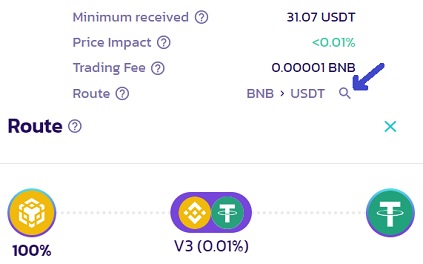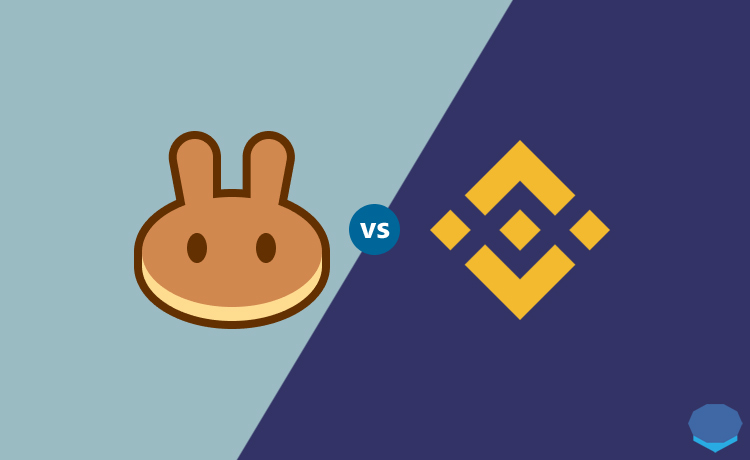Do you think PancakeSwap or Binance has lower fees?
Let’s compare PancakeSwap and Binance fees and find out how much fees you would pay when you trade on each exchange.
PancakeSwap fees vs. Binance fees: Which exchange has lower fees?
PancakeSwap v2 had a trading fee of 0.25%.
With the release of PancakeSwap v3, the platform now has three more fee tiers: 0.01%, 0.05% and 1%.
For example, if you buy a token on PancakeSwap with 2000 BUSD, you will be charged a fee of 5 BUSD assuming a 0.25% fee.
The calculation is simple: 2000/100*0.25 = 5.
To see how much fees you will be charged when you make a swap on PancakeSwap, you can click the route as shown below.

If you make the same trade on Binance, you will be charged a trading fee of 0.10% or lower.
So you can pay 2 BUSD instead of 5 BUSD by trading on Binance (2000/100*0.10).
However, if the pair that you trade on PancakeSwap has a fee of 0.01% or 0.05%, it could be better to trade on PancakeSwap.
Binance has also various fee discounts and zero-fee trading pairs.
Trading selected BTC, fiat and BUSD pairs on Binance incurs zero fees.
If you don’t have a Binance account yet, you can click the button below or use the referral ID ”WRYOO8BZ” to open your Binance account with a 20% fee discount:
If you already have a Binance account, you can use the code ”long90” when opening your Futures account on Binance and start trading on the platform.
If you’ve opened your Binance account with a 20% fee discount and also use BNB to pay for fees, you will be charged a fee of 0.075% on your trades and then receive a 20% fee kickback.
For a trade worth 2000 BUSD, the fee will be 1.5 BUSD worth of BNB (2000/100*0.075).
And you will also receive a fee kickback of 0.3 BUSD worth of BNB (1.5/100*20).
If we deduct the fee kickback from the fee charged, the actual fee paid on the trade will be 1.2 BUSD worth of BNB (1.5-0.3).
So this way you actually pay a fee of 0.06% (2000/100*0.06 = 1.2).
PancakeSwap, on the other hand, has a flat fee of 0.25% or varying fees of 0.01%, 0.05%, 0.25%, and 0.1% (V3), and does not offer any fee discounts.
While on Binance, you can pay a 0.1% or even as low as 0.06% fee on your trades.
Also, depending on your trading volume and VIP level, you can be charged fees lower than 0.06% on your maker trades on Binance.
As PancakeSwap is a decentralized exchange, you also need to pay transaction fees when you make a swap on the platform.
Transaction fees on BSC are pretty low compared to other networks like Ethereum.
It’s currently around $0.1-0.5 USD worth of BNB per trade, so you don’t need to worry about it much.
Also, when you want to trade a token on PancakeSwap, you first need to enable the token (allowing the smart contract to spend your token).
This will incur a transaction fee as well. It is only one time transaction, but must be done for different tokens that you want to trade as well.
If you’ve never traded on PancakeSwap, you can check out our tutorial to learn how to buy and sell tokens on PancakeSwap.
As we compare Binance to PancakeSwap, a decentralized exchange based on BNB Smart Chain (BSC).
It should also be useful to mention the withdrawal fees via BSC on Binance.
BNB withdrawal fee via BSC on Binance is currently 0.0005 BNB, around $0.15 USD.
If you withdraw BUSD, USDT and ETH via BSC from Binance, the transaction fee is currently around $0.1-0.2 and can be zero for BUSD withdrawal.
So there is currently no disadvantage related to transaction fees when you trade and withdraw BNB and tokens that are also available on BSC on Binance.
If you are interested in trading on Binance and PancakeSwap, check out our guides below to learn more about fees, trading and staking:
If you have any questions about PancakeSwap and Binance fees, you can leave a comment below.





















